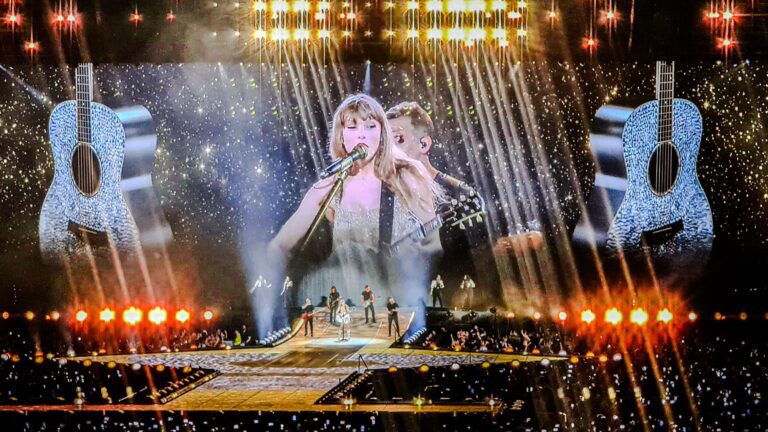
This summer we have seen the likes of Coldplay, Ed Sheeran and Green Day embarking on huge world tours plus, of course, as every Swiftie knows, Tay-Tay ended the European leg of her epic Eras tour this month at Wembley Stadium. The sheer scale of these rock extravaganzas is often staggering, and it goes without saying that putting on a stadium concert consumes a lot of energy and generates a fairly hefty carbon footprint.
Power generation
Power generation is the first major energy consideration when putting on a concert, accounting for about 35% of total emissions. Live music across all venues in the UK generates 400,000 tonnes of greenhouse gases every year, and if you break-down the figures for single events such as a Taylor Swift concert, it is easy to see how. On each performing day of her Eras tour, Sparks (certainly) Fly, with circa 10,000 Kilowatt Hours (kWh) of electricity consumed for lighting, sound amplification and general site operations. In total, the UK leg of the Eras tour used circa 300,000 kWh of electricity – enough to power 200 houses for an entire year.
On top of direct generation, there is indirect power generation in the lead-up to events. So, for example, when Taylor Swift tickets went on sale for her Paris concerts, EDF (Electricite de France) reported energy surges, as over 900,000 hopeful punters logged on to the ticketing site simultaneously! Then there is merchandise to consider.
The production process of one standard cotton t-shirt emits 5.2 kgCO2e so, if we assume that 25% of an 80,000 audience purchases a t-shirt (Swiftie “merch” sales were $200m in 2023), then those sales would generate 104t CO2e per concert. With 150 shows to consider, we conservatively estimate that the Eras tour generated 16,000t CO2e on T-shirt sales alone!
As for Tay-Tay’s own clothing, we don’t have any corresponding stats for energy and carbon, but the artiste does get through 12 costumes per show. As she might say herself, she certainly has Style…!
Travel
The global nature of music tours predictably means inordinate amounts of travel. Coldplay’s current Music of the Spheres World Tour (9 million tickets sold) will put on 177 concerts in 20 different countries, whilst Green Day’s Saviors Tour is only 31 concerts, but still takes in 4 different continents.
The Eras tour comprised 152 shows in 54 cities and relies on around 75 articulated trucks to transport the entire set from city to city, consuming around 500,000 litres of diesel per month.
But the real constant of globe-spanning musical tours is endless air travel, and Taylor Swift is America’s biggest user of private jets (ahead of 2nd placed Floyd Mayweather and Jay-Z). This still only accounts for a fraction of the total air miles associated with music tours, because fans frequently travel to concerts by plane.
It is estimated that up to 20% of fans have flown to attend Taylor Swift concerts, and at this month’s Wembley events, around 12% of the ticket holders were international visitors – mainly from USA, Canada, France and Spain. When the Eras tour hit the antipodes, Air New Zealand added 2,000 additional seats to cover demand, whilst Quantas added 16 flights and 4,800 extra tickets.
Sustainability
All of this tells us that mega music events are not particularly environmentally friendly, and to counter this situation, some bands are doing their bit with mitigation efforts. Coldplay led the way back in 2019, when they declared that they would not tour again until they could create a more sustainable global touring model.
At the time this was dismissed as nothing more than a Rush of Blood to the Head, but the band’s latest tour suggests this was not the case. In fact, significant efforts have been made, regarding sustainability, that extend beyond mere greenwash.
Stage production is now almost entirely powered by renewable energy contracts, whilst at each outdoor venue, solar photovoltaic panel arrays are installed for localised power generation.
This is topped up by kinetic dance floors(!) and power-bikes, all of which generate an incremental 17 kWH of electricity per show – enough to fully power one of the smaller stage areas. All logistical support for the Coldplay tour is powered by Renewable Diesel (diesel from waste) wherever it is available (so Europe basically), whilst to date, 5m trees have been planted with the intention of planting a further 4m to represent every concert-goer for the overall tour.
The world is not going to stop loving concerts because of associated carbon footprints and with the huge economic benefits stemming from global music tours, the last thing that any music venue is going to say to the likes of Taylor Swift is We Are Never Ever Getting Back Together. On that basis, Coldplay’s Viva la Vida approach looks to be the model to follow for environmentally conscious bands.
Portland Fuel

www.stabilityfromvolatility.co.uk
Image credit: Dreamstime

